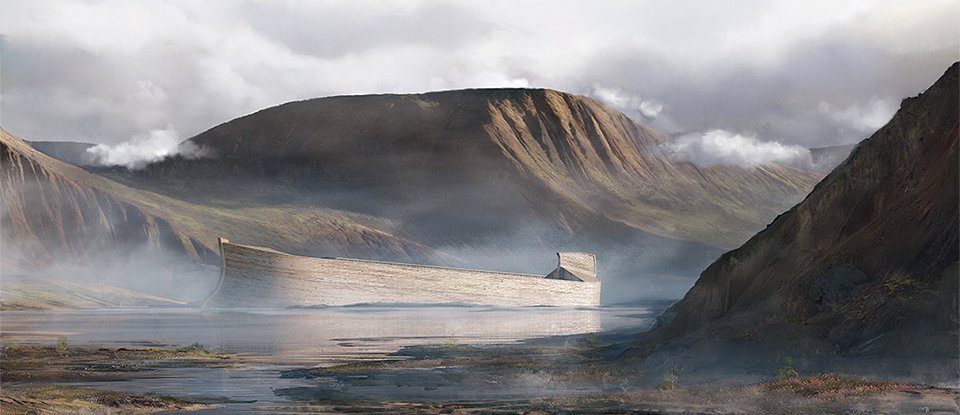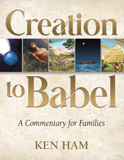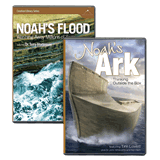Life After the Flood
God blessed Noah’s obedience—but that doesn’t mean life after departing the ark was easy.
“Go out from the ark, you and your wife, and your sons and your sons’ wives with you. Bring out with you every living thing that is with you of all flesh—birds and animals and every creeping thing that creeps on the earth—that they may swarm on the earth, and be fruitful and multiply on the earth.” (Genesis 8:16–17)
Surely God’s words replayed in Noah’s mind as he watched his sons race to remove the final pegs that secured the door shut. Soon they would all set foot on dry ground for the first time in a year.
Hearing the Creator speak directly was an indescribable experience. On previous occasions prior to the flood, the strange blend of intense fear and reassuring peace coursed through Noah. Those emotions were followed by the monumental tasks of building the ark and loading it. This time, hope surged to the forefront of his emotions as he imagined what lay beyond the door. Where would they settle? How long would he have to wait to hold a grandchild? What would the new world be like? He had glimpsed portions of this alien landscape after removing the ark’s covering, but he craved feeling the earth between his toes and the warmth of the sun on his face.
His wife hooked her arm in his and looked up at him expectantly as the last peg clunked to the floor. The animals chittering nearby quickly drowned out its echo.
“Come on. Help me push.” Ham hustled to the outer edge of the door, and his brothers hurried to join him. The men braced themselves, and with a loud grunt, they gave a mighty shove.
With an ear-splitting crack, the door broke free from the layer of pitch Japheth had slathered on it after the Lord shut them in. The metal hinges creaked and timbers groaned as the massive door swung to the side. Noah inhaled the fresh air deeply, and using his free hand, shaded his eyes from the golden sunbeams that streamed in.
Japheth beckoned the group with a wave of his arm. “Let’s go.”
“Wait!” Shem lunged and pulled him away from the opening.
Japheth glared at him, but his expression softened when he looked back toward the door. “Thank you.”
“What is it?” Noah walked forward and joined Ham who was peering over the edge of the opening.
Ham pointed down. “We’re more than five cubits above the ground.”
Noah sighed. His first steps on dry ground would need to wait a little longer.
We live in a world consumed by hatred, violence, sexual immorality, and a host of other sins. This culture presents numerous challenges to Christians as we desire to live in a way that honors our Creator, but he has given us all that we need to lead godly lives, such as the gifts of the Holy Spirit and his inspired Word. We can also learn from the examples of our heroes of the faith, like Noah.
Have you ever wondered what life must have been like for Noah’s family once the flood ended? What trials did they face as they set out to restart civilization? Though the Bible doesn’t give us a description of what the world was like when Noah disembarked, we can reconstruct many of the details with what we do know. And the first challenge would have been to get off the ark.
Disembarking the Ark
Loading the ark was a major operation. It may have taken an entire week just to load the animals—seven days passed from the time God told Noah to enter the ark and their final entry into the vessel on the day the flood began (Genesis 7:1–4, 11–13). Disembarking was likely easier in some respects. For example, they could have released the birds by simply opening their cages and allowing them to find their own way to the door or possibly through an open roof, depending on what it means that “Noah removed the covering of the ark” (Genesis 8:13).
Unloading the remaining animals may have been far more time consuming. We’ve all seen pictures of the completed ark with animals loading onto the second deck via a long ramp. Obviously, such a ramp would not have been available after the flood. If the door they had entered also served as the exit and was on the second deck, they would need to construct a new ramp or repurpose an interior ramp to reach the ground. Of course, it is possible the ark settled in such a way that the door ended up next to a rise in the ground, which would make things easier. Once the exterior ramp was completed, the animals could be led to the second deck and to the door to be set free. In a reversal of the loading procedure, short and relatively steep internal ramps could have been used to move animals from the first or third deck to the second.
Back on Dry Land
Imagine what it must have felt like to walk on the earth for the first time in a year.
Imagine what it must have felt like to walk on the earth for the first time in a year. The bleak landscape must have offered little comfort. Apart from the animals that had just left the ark, wildlife was nonexistent, so spotting a wild animal may have quickly become a rare event. This must have seemed strange to people who were accustomed to interacting with animals daily. Also, the unwelcoming scene bore few signs of life. Perhaps shrubs, grasses, and other small plants dotted the terrain, but no trees could be found save for some saplings, as evidenced by the olive leaf carried by the dove (Genesis 8:11). Land animal carcasses would not have survived to this point, but the pungent remains of sea creatures might have been seen if they had been trapped in shrinking pools on the quickly drying mountain.
After the family finally set foot on the soil once again, Noah built an altar on which he sacrificed at least one of each kind of clean creature (Genesis 8:20). The Bible does not reveal what material he used to construct the altar—perhaps they repurposed bits of the ark or materials they brought with them, or maybe they gathered stones that had settled on the mountain.
God blessed Noah and his sons, telling them to multiply and fill the earth. But before they could fill the earth, Noah’s family had to figure out how to survive in a strange new world.
Since it took more than two months from the time the ark landed until nearby mountain peaks emerged (Genesis 8:4–5), it seems reasonable that the ark came to rest near the top of the mountain. While the climate may have remained warm for a while due to elevated ocean temperatures, a mountaintop is generally not a great place to live, since it often lacks sufficient food and water. Thus, Noah’s family likely would have needed to descend and settle near a dependable water source, such as a mountain stream or river.
Starting a settlement near water brings other benefits, particularly related to meeting the next basic need—food. If they were to grow successful crops, they needed fertile soil, which was probably abundant at this point, due to nutrient-rich soil deposited by the flood. However, over the years, the nutrients for the soil in a river valley would be replenished by seasonal flooding. Even with the perfect location selected, it may have taken many months before they could enjoy food from a harvest. Noah’s family may have initially survived on grain reserves from the ark, but fresh produce would not have been on the menu for a while.
The other food options included the animals. Until this point, the Lord had not permitted man to eat meat (Genesis 1:29). But after Noah’s family disembarked the ark, God gave them permission to eat any “moving thing that lives” (Genesis 9:3). Assuming Noah’s family had faithfully followed the original dietary instructions of eating only green plants, the thought of eating animals for the first time must have been a bit unsettling, especially after living in close quarters with them for over a year. Living near water meant that fish were readily available. And as time went on and the wild animals multiplied, they could frequent the water source, giving Noah’s family better hunting opportunities.
Another food source was the clean animals, which may be one of the reasons the Lord sent seven pairs (or seven) of each clean kind, such as the cattle and goat/sheep kinds. Besides being food sources, these creatures were likely very useful for Noah’s family. Just as today, some of them could be hooked up to a plow or used to power a mill, and others might have provided milk that could be processed into cheese and other products.
These animals likely also helped with clothing and shelter needs. The wool sheared from sheep could have been woven into articles of clothing. Animal hides have long been used for clothing and shoes or sandals. The hides could also be stretched and stitched together to create a tent covering.
Some people have suggested that Noah’s family might have reused wood from the ark to build shelters, but this is unlikely. The infamous incident involving Ham reveals that Noah slept in a tent (Genesis 9:21). The tent posts may have come from the ark, but the covering was likely made of animal skins. Also, this event occurred at least a few years after the flood. Noah had already planted a vineyard and made wine from its fruit, but grapevines generally do not yield fruit until after three years. Also, Ham’s son Canaan was cursed because of this incident, and if Genesis 10:6 lists Ham’s sons in their order of birth, then Canaan would have been his fourth son.
Restarting Civilization
Once they developed solutions to meet life’s necessities, Noah’s family could focus on other aspects of restarting civilization. We know that they followed God’s command to “be fruitful and multiply” but they did not “fill the earth” (Genesis 9:1). The Bible explains that everyone on earth came from Shem, Ham, and Japheth (Genesis 10:32), so we can deduce that Noah did not have any other children after the flood. However, it was not long before he had plenty of grandchildren.
The incident involving Ham hints at another detail about the Lord’s command to fill the earth. Ham told his brothers about what happened, and then Shem and Japheth promptly took action to cover their father’s nakedness (Genesis 9:23). So all three sons were apparently still in the same area as Noah. This makes good sense in the first generation, since the children of Shem, Ham, and Japheth undoubtedly intermarried. That is, first cousins married each other, which was not a problem at that time—close relatives were the only options and the law against close intermarriage was not given until Moses’ day several hundred years later (Leviticus 18–20).
It is likely the earth was a dangerous place as it settled from the flood.
It is hard to blame the family for sticking together for the first few generations. After all, there were no other people in the entire world, and it would be difficult to make another new start in a different location after they had recently settled. The earth was likely a dangerous place, with earthquakes and volcanic activity happening as the earth settled from the catastrophic plate movement during the flood.
Eventually, they did look for a new place. Genesis 11:2 speaks of Noah’s descendants finding a place to dwell in the land of Shinar, probably in Mesopotamia. But instead of obeying God’s command to fill the earth, they sought to make a name for themselves. At a place now known as Babel, they started building a city and a tower until God confused their languages, forcing them to cease their work and grudgingly obey his command to disperse.
They should have learned from their forefather Noah, who did all the things the Lord commanded him to do (Genesis 6:22) and saved his family and the animals on the ark because of his obedience.
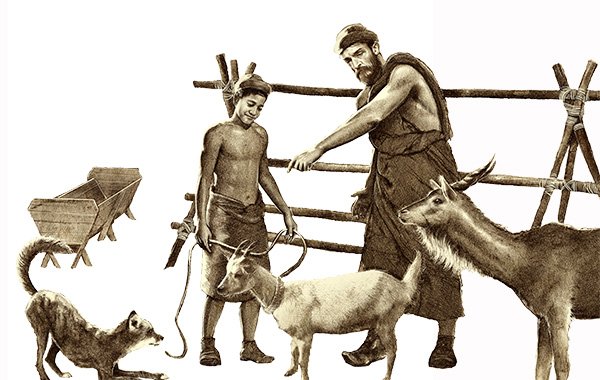
Our Obedience
The examples set by Noah and his early descendants serve as important reminders for us today. God commanded them to do difficult, frightening, uncomfortable tasks, more challenging than we can even imagine. But God has reasons for the instructions he gives. Just as he blessed Noah’s obedience and provided for him and his family, he will also provide for us when we trust him.
But like Noah’s descendants at Babel, believers can face the Lord’s chastisement when they disobey him (Hebrews 12:5–6), and unbelievers are in danger of eternal judgment unless they turn to him in faith and believe the gospel of Jesus Christ. So if the Lord commands us to do something difficult and uncomfortable, we can be confident that he knows what he is doing and what is best for us. Our job is to gratefully serve him, seeking in all things to magnify his name rather than our own.
Behind the Art
Art Director Chris Neville’s thoughts on creating the cover art for “Life After the Flood”
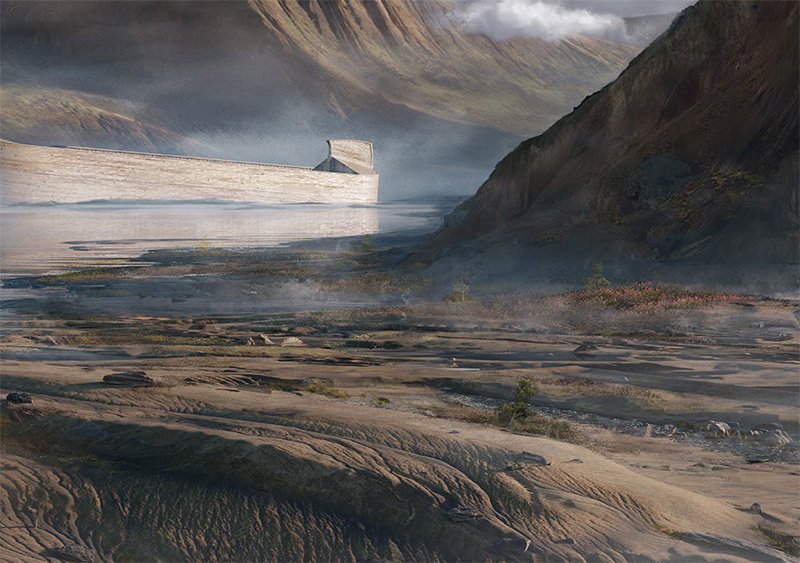
The world must have been an alien place after the global cataclysm. As I thought about the art for “Life after the Flood,” I imagined the barren landscape scarred and shaped by the waters receding to lower elevations.
The account of Genesis 8:4–5 gives some interesting clues as to what this scene might have looked like. In many depictions we see the ark perched high on the tallest peak of a singular mountain. But when creating this image, I chose to look at the scene from a slightly different angle. After all, the account of Noah’s great flood is a historical event, not tied down to the typical artistic representation. I hope I created a unique view that would make us reimagine this scene as it might have been—not just as we’ve always pictured.
Verse 4 (NASB) tells us, “In the seventh month, on the
seventeenth day of the month, the ark came to rest on the
mountains of Ararat.
” It could have been the single tallest
peak, or it could have been high in the mountains.
Verse 5 (NASB) adds details about the recession of the
water that has led many to believe the ark rested on the tallest
peak: “And the waters continued to abate until the tenth
month; in the tenth month, on the first day of the month, the
tops of the mountains were seen.
” Based on verse 4, I didn’t
want to show the ark stranded upon a single peak, but I imagined
that in God’s provision he allowed the ark to settle amid
the mountain range in a place where the inhabitants could
disembark without climbing gear. Not ignoring verse 5, I imagine
that Noah, looking out from the ark toward the camera,
would have seen the tops of the surrounding peaks becoming
visible during his long wait for the water to recede.
We don’t know exactly what the events of the Bible looked like. But we can be sure that God’s written Word is true when it comes to the past, present, and future.
Answers Magazine
July–September 2022
Recommended Resources

Answers in Genesis is an apologetics ministry, dedicated to helping Christians defend their faith and proclaim the good news of Jesus Christ.
- Customer Service 800.778.3390
- © 2024 Answers in Genesis


